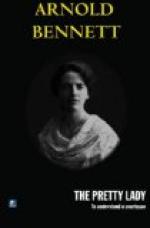The floors of the Reynolds Galleries were covered with some hundreds of very well-dressed and very expensively-dressed women and some scores of men. The walls were covered with a loan collection of oil-paintings, water-colour drawings, and etchings—English and French, but chiefly English. A very large proportion of the pictures were portraits of women done by a select group of very expensive painters in the highest vogue. These portraits were the main attraction of the elegant crowd, which included many of the sitters; as for the latter, they failed to hide under an unconvincing mask of indifference their curiosity as to their own effectiveness in a frame.
The portraits for the most part had every quality save that of sincerity. They were transcendantly adroit and they reeked of talent. They were luxurious, refined, sensual, titillating, exquisite, tender, compact, of striking poses and subtle new tones. And while the heads were well finished and instantly recognisable as likenesses, the impressionism of the hands and of the provocative draperies showed that the artists had fully realised the necessity of being modern. The mischief and the damnation were that the sitters liked them because they produced in the sitters the illusion that the sitters were really what the sitters wanted to be, and what indeed nearly every woman in the galleries wanted to be; and the ideal of the sitters was a low ideal. The portraits flattered; but only a few guessed that they flattered ignobly; scarcely any even of the artists guessed that.
The portraits were a success; the exhibition was a success; and all the people at the private view justly felt that they were part of and contributing to the success. And though seemingly the aim of everybody was to prove to everybody else that no war, not the greatest war, could disturb the appearances of social life in London, yet many were properly serious and proud in their seriousness. It was the autumn of 1915. British troops were triumphantly on the road to Kut, and British forces were approaching decisive victory in Gallipoli. The Russians had turned on their pursuers. The French had initiated in Champagne an offensive so dramatic that it was regarded as the beginning of the end. And the British on their left, in the taking of Loos and Hill 70, had achieved what might have been regarded as the greatest success on the Western Front, had it not been for the rumour, current among the informed personages at the Reynolds Galleries, that recent bulletins had been reticent to the point of deception and that, in fact, Hill 70 had ceased to be ours a week earlier. Further, Zeppelins had raided London and killed and wounded numerous Londoners, and all present in the Reynolds Galleries were aware, from positive statements in the newspapers, that whereas German morale was crumbling, all Londoners, including themselves, had behaved with the most marvellous stoic calm in the ordeal of the Zeppelins.




